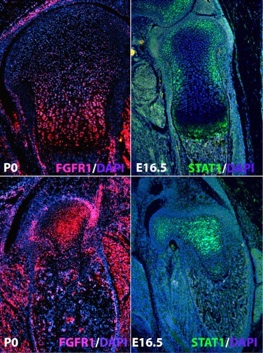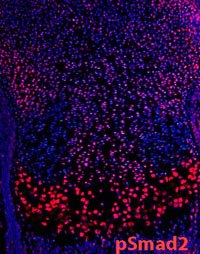Pathway interaction in the growth plate. We are also studying how BMP signaling pathways interact with other major pathways that operate in the growth plate. For example, we found that BMP and FGF pathways act antagonistically at multiple stages of chondrocyte proliferation and differentiation, and that a major target of both pathways is the secreted factor Indian Hedgehog (IHH). We found that IHH is activated directly by BMPs through canonical Smad pathways. We are currently identifying other essential targets of BMP pathways.
Transforming Growth Factor Beta (TGF-beta) signaling pathways. The ability of TGF-betas to promote chondrogenesis in vitro has been known for decades, but the roles of TGF-beta pathways in vivo in the growth plate remain poorly defined. We are investigating these roles in vivo by generating mice deficient in type I TGF-beta receptors and the TGF-beta Smads, Smads 2 and 3. Interestingly, in contrast to the BMPs, TGF-beta seem to exert their effects in chondrocytes primarily through non-canonical pathways. We are currently identifying these non-canonical pathways.
Inhibitory Smad action in the growth plate. The activity of BMP and TGF-beta pathways in skeletal tissues must be tightly controlled. While the importance of extracellular inhibitors of these pathways has been established, less is known about intracellular inhibition. We are investigating the roles of the inhibitory Smads (I-Smads) Smad6 and Smad7.


